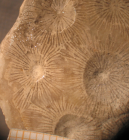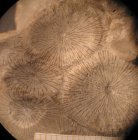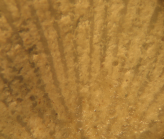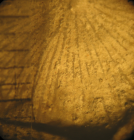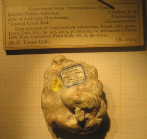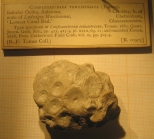Scleractinia name details
Dermosastraea Beauvais, 1970 †
1581497 (urn:lsid:marinespecies.org:taxname:1581497)
unaccepted > junior subjective synonym
Genus
Confusastraea tenuistriata Tomes, 1882 † accepted as Isastrea tenuistriata (Tomes, 1882) † (type by original designation)
marine, fresh, terrestrial
fossil only
Beauvais L. (1970). Sur quelques générés nouveaux ou peu connus de Madréporaires jurassiques. <em>Eclogae geologicae Helvetiae.</em> 63 (3): 1109-1131. [details]
Description Massive cerioid corallum with polygonal corallites. Holotheca present. Mode of increase difficult to define, new corallites...
Status The name is available but Dermosastraea is considered as a junior synonym of Isastrea.
Description Massive cerioid corallum with polygonal corallites. Holotheca present. Mode of increase difficult to define, new corallites appear at the edge of the lamellar colony; the lectotype shows a central corallite bigger than others. Radial elements are compact, free or occasionally anastomosed, attenuated, straight to curved septa. Distal edge with small acute regularly spaced teeth, inner edge not visible, lateral faces probably with subvertical carinae, no pali. Microstructure unknown. Hexameral symmetry difficult to decipher if present, bilateral symmetry marked by curvature of septa. Endotheca made of dissepiments , columella absent but inner edges join in depth of the axial zone, synapticulae limited at the wall region, wall similar to typical Isastrea. In some places but not everywhere, a small groove exists between the outer edges of adjacent corallites. [details]
Status The name is available but Dermosastraea is considered as a junior synonym of Isastrea.
Status The name is available but Dermosastraea is considered as a junior synonym of Isastrea. [details]
Hoeksema, B. W.; Cairns, S. (2025). World List of Scleractinia. Dermosastraea Beauvais, 1970 †. Accessed at: https://www.marinespecies.org/scleractinia/aphia.php?p=taxdetails&id=1581497 on 2025-05-12
Date
action
by
original description
Beauvais L. (1970). Sur quelques générés nouveaux ou peu connus de Madréporaires jurassiques. <em>Eclogae geologicae Helvetiae.</em> 63 (3): 1109-1131. [details]
basis of record Cairns, S.D., R. Baron-Szabo, A.F. Budd, B. Lathuilière, E. Roniewicz, J. Stolarski & K.G. Johnson. (2010). Corallosphere. , available online at http://www.corallosphere.org [details]
source of synonymy Vasseur, R., Lathuilière, B. (2021). Pliensbachian corals from the Western Tethys. <em>Geodiversitas.</em> 43(22): 1187-1291., available online at https://doi.org/10.5252/geodiversitas2021v43a22 [details]
basis of record Cairns, S.D., R. Baron-Szabo, A.F. Budd, B. Lathuilière, E. Roniewicz, J. Stolarski & K.G. Johnson. (2010). Corallosphere. , available online at http://www.corallosphere.org [details]
source of synonymy Vasseur, R., Lathuilière, B. (2021). Pliensbachian corals from the Western Tethys. <em>Geodiversitas.</em> 43(22): 1187-1291., available online at https://doi.org/10.5252/geodiversitas2021v43a22 [details]
 Present
Present  Inaccurate
Inaccurate  Introduced: alien
Introduced: alien  Containing type locality
Containing type locality
From editor or global species database
Description Massive cerioid corallum with polygonal corallites. Holotheca present. Mode of increase difficult to define, new corallites appear at the edge of the lamellar colony; the lectotype shows a central corallite bigger than others. Radial elements are compact, free or occasionally anastomosed, attenuated, straight to curved septa. Distal edge with small acute regularly spaced teeth, inner edge not visible, lateral faces probably with subvertical carinae, no pali. Microstructure unknown. Hexameral symmetry difficult to decipher if present, bilateral symmetry marked by curvature of septa. Endotheca made of dissepiments , columella absent but inner edges join in depth of the axial zone, synapticulae limited at the wall region, wall similar to typical Isastrea. In some places but not everywhere, a small groove exists between the outer edges of adjacent corallites. [details]Remark The lectotype is strongly mechanically and chemically prepared as often in the material of Crickley described by Tomes. It is highly probable that an important part of the groove around the corallites at the place of the wall is artificial. This character was used by Beauvais to erect Dermosastraea. The second character is the perforation of septa. As the preparation of the holotype often cut the surface at a very short distance of the initial distal edge of septa, we get in many places the feeling of a perforate pattern. Deep sections show compact septa with some well characterised bioerosion borings in some places. In revenge, it is true that I. tenuistriata differs from typical Isastrea by a less regular ornamentation of septa and more numerous anastomoses. [details]
Status The name is available but Dermosastraea is considered as a junior synonym of Isastrea. [details]
